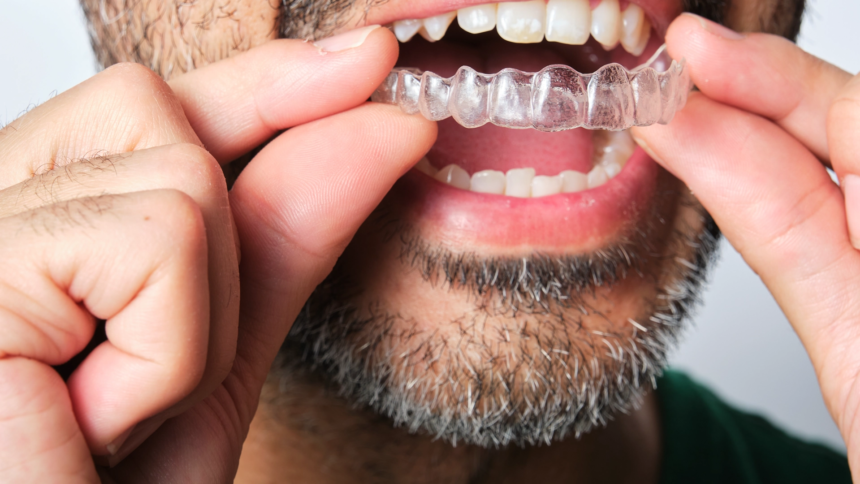Clear braces are devices made of transparent materials used to correct dental alignment problems. These braces work like traditional metal braces but are less noticeable. Clear braces exert mild and continuous force on the teeth to align them properly without causing discomfort.
Common Orthodontic Problems Addressed by Clear Braces
Teeth aligners are used to treat several orthodontic conditions, including:
- Overcrowding occurs when teeth are closely positioned, which makes it challenging to brush or floss properly. This can lead to poor oral hygiene and a higher risk of cavities and gum disease.
- Gapping between teeth may affect your smile and cause food particles and bacteria to accumulate. Teeth aligners gradually reduce these spaces, helping to improve your smile, prevent plaque buildup, and reduce the likelihood of gum disease.
- Misalignments like overbite or underbite, when the upper or lower teeth protrude over the other, can be corrected with clear braces. Bite alignment helps promote proper chewing and speaking and safeguards the jaw’s function.
- Crossbites, when the teeth do not align uniformly when biting down, can result in the premature wearing of the teeth and even gum recession. Braces help correct this while maintaining the health of the teeth.
Tips to Follow During Your Teeth Aligner Treatment
Following the right tips when wearing teeth aligners helps confirm that the treatment is effective and progresses as expected. Here are some key tips to follow during teeth aligner treatment:
Wear Your Aligners as Directed
To achieve the intended outcomes, use your aligners according to the instructions provided by your orthodontist. Only remove them when eating, drinking, or brushing your teeth. Following this schedule helps maintain consistent tooth movement throughout the treatment. To avoid forgetting to replace aligners, set alarms on your phone or write reminders to make sure the practice is consistent.
Store Your Aligners in a Designated Case
Keep the aligners in the provided case when not in use to avoid damage, loss, or contamination. Do not put them in napkins or tissues, as this makes it easy for them to be misplaced. Invisible braces can also crack or chip easily when dropped. Carrying the protective case with you at all times confirms that your aligners are safe and easily accessible.
Maintain Proper Oral Hygiene
Proper dental care confirms that no food particles and bacteria get trapped between the aligners and the teeth, which may cause discomfort or other dental problems like tooth decay. Clean your teeth with a toothbrush and dental floss after each meal before placing the aligners back in your mouth. To prevent gum and tooth damage, use fluoride toothpaste and a soft bristle toothbrush. Rinse with water or mouthwash to keep the oral cavity clean.
Clean your invisible braces with a clear, non-scented hand soap and a soft-bristled toothbrush. Toothpaste can scratch the braces’ surface. Hydrogen peroxide may help remove stains, while white vinegar eliminates hard buildup.
Replace Your Aligners as Directed
Aligners are worn for a certain amount of time and then replaced with the next set to maintain the process of teeth realignment. Replacing aligners on time confirms that the treatment does not deviate from the planned schedule. To prevent treatment delays, use calendar reminders or alarms. Stick to your orthodontist’s appointment schedule, as it is based on the treatment plan.
Use Your Chewies
Chewies are small, soft tools that help aligners fit well on the teeth. Chewing them after replacing aligners helps them fit securely against the teeth and eliminates air pockets. Their use is also significant when changing to the next set of aligners, as the new pair may feel slightly tight or not fully settled. Use chewies frequently to maintain the constant movement of teeth and increase the effectiveness of the treatment.
Choose a Certified Orthodontist
Teeth aligners are an effective and less noticeable method of correcting orthodontic issues. Consulting an orthodontist who uses modern technology like digital imaging and scanning confirms that the aligners fit properly and are tailored to meet your needs. An orthodontist also explains the treatment plan and the procedures involved. If you are thinking about getting aligners or are already undergoing treatment, these tips can help enhance the outcome. Start your journey toward a beautiful smile by booking an appointment with a professional orthodontist today.


